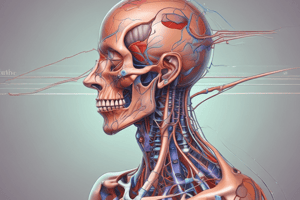Podcast
Questions and Answers
What is the most common cause of death worldwide?
What is the most common cause of death worldwide?
- Cancer
- Coronary artery disease (correct)
- Epilepsy
- Multiple sclerosis
What is the function of the gallbladder?
What is the function of the gallbladder?
- To store bile (correct)
- To provide structure and movement to the body
- To break down food into small, nutritional molecules
- To send signals from one part of the body to another
What is the primary purpose of the external male reproductive system?
What is the primary purpose of the external male reproductive system?
- To nurture the offspring
- To protect the testis
- To provide structure and movement to the body
- To transport and sustain gametes (correct)
Flashcards are hidden until you start studying
Study Notes
-
The human body is composed of trillions of cells and non-cellular components.
-
The body is made up of four main types of tissue: lining cells, connective tissue, nerve tissue, and muscle tissue.
-
Cells that lie on surfaces exposed to the outside world or gastrointestinal tract (epithelia) or internal cavities (endothelium) come in numerous shapes and forms.
-
Lining cells regulate what can and can't pass through them, protect internal structures, and are responsible for the body's natural barrier function.
-
Endothelial cells line internal cavities and are important in the body's blood vessel function.
-
Muscle tissue is responsible for movement and is composed of many different types of cells.
-
Genes are the genetic instructions that dictate a cell's function and gene expression.
-
Proteins are the building blocks of proteins and are responsible for cell function and structure.
-
DNA is the genetic instructions that dictate a cell's characteristics.
-
Tissues are composed of cells that have a specialised function.
-
The heart is a muscular organ located in the thoracic cavity between the lungs and slightly to the left. It pumps blood around the body to deliver oxygen, nutrients, waste, hormones, and white blood cells.
-
Coronary artery disease is the leading cause of death worldwide, making up 16% of all deaths.
-
Cancer can affect the heart, though it is exceedingly rare and has usually metastasized from another part of the body.
-
The gallbladder is a hollow pear shaped organ located posterior to the inferior middle part of the right lobe of the liver. It stores bile before it is released into the small intestine.
-
The gallbladder gets its blood supply from the cystic artery which in most people emerges from the right hepatic artery.
-
The human body is composed of many different parts, each with a specific function.
-
The digestive system breaks down food into small, nutritional molecules for absorption into the body.
-
The endocrine system is responsible for sending signals from one part of the body to another.
-
The immune system helps the body to distinguish its own cells and tissues from outside cells and substances.
-
The integumentary system provides protection and contains other important organs.
-
The lymphatic system helps the body to extract, transport and metabolize lymph.
-
The musculoskeletal system provides structure and movement to the body.
-
The skeleton contains bone marrow, which is responsible for the production of red blood cells.
-
The musculoskeletal system also contains muscles, which are responsible for movement.
-
The nervous system consists of the body's neurons and glial cells, which together form the nerves, ganglia and gray matter which in turn form the brain and related structures.
-
The brain is the organ of thought, emotion, memory, and sensory processing; it serves many aspects of communication and controls various systems and functions.
-
The peripheral nervous system (PNS) is mostly responsible for gathering information with sensory neurons and directing body movements with motor neurons.
-
The nervous system is subject to many different diseases. In epilepsy, abnormal electrical activity in the brain can cause seizures. In multiple sclerosis, the immune system attacks the nerve linings, damaging the nerves' ability to transmit signals.
-
Female puberty generally occurs between the ages of 9-13 and is characterized by ovulation and menstruation. The growth of secondary sex characteristics such as growth of pubic and underarm hair, breast, uterine and vaginal growth, widening hips and increased height and weight also occur during the female puberty process.
-
The external male reproductive system is made up of the penis and the scrotum which is a bag that protects the testis.
-
The penis consists of the glans which is the head of the penis and contains the urethra and urinary meatus the point where urine exits the penis, the rest of the penis is called the shaft.
-
The external male reproductive system is responsible for the transportation and sustaining of the gametes and to nurture the offspring.
Studying That Suits You
Use AI to generate personalized quizzes and flashcards to suit your learning preferences.



